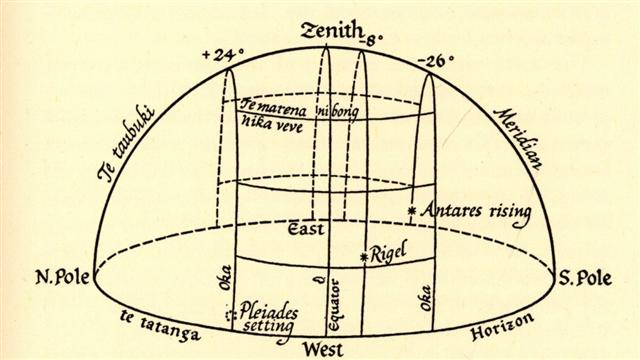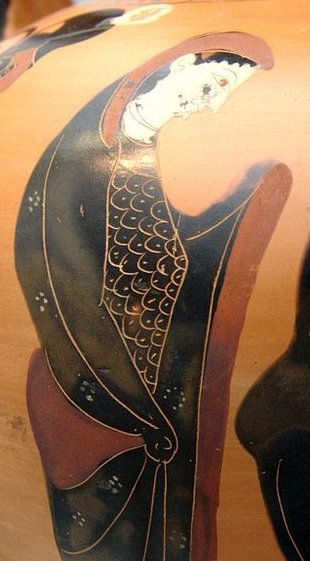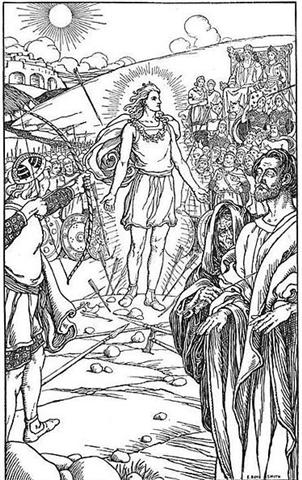If the blind and pregnant bird in Cb2-13 was drawn to be a contrast to the Eye (Ain) in Taurus, then we ought to read 'darkness is here': ... Ta'aroa sat in his heaven above the earth and conjured forth gods with his words. When he shook off his red and yellow feathers they drifted down and became trees. He created the first parents, Tumu-nui, Great Foundation, to be the husband, and Paparaharaha, Stratum Rock, to be the wife. He put the very essence of himself into their creation; yet when he commanded them to wed, each refused to go to the other. So Ta'aroa created other gods and Atea, Bright Expanse, the Sky-goddess, who dwelt in darkness in the confined sky Rumia. By Papa-tuoi, Thin Earth, Atea was the mother of children who became artisans for Rai-tupua-nui, Great-Sky-builder. They assisted him in erecting the ten heavens above the earth. In the highest of these dwelt the god Tane, so it was called the Sky-of-the-sacred-omens of Tane and Sky-of-the-water-of-life of Tane. The next highest heaven was called Hiro's Sky-of-prophets. Atea then became the wife of Rua-tupua-nui, Source of Great Growth, and they became the parents of all the celestial beings, first the shooting stars, then the Moon and the Sun, next the comets, then the multitude of stars and constellations, and finally the bright and dark nebulae. When this tremendous task had been accomplished Atea took a third husband, Fa'a-hotu, Make Fruitful. Then occurred a curious event. Whether Atea had wearied of bringing forth offspring we are not told, but certain it is that Atea and her husband Fa'a-hotu exchanged sexes. Then the [male] eyes of Atea glanced down at those of his wife Hotu and they begat Ru. It was this Ru who explored the whole earth and divided it into north, south, east, and west ...
This darkness was not necessarily an indication of the autumn season. It could instead have been related to how Antares as Sun king (alias Hotu Matua) was due to arrive, i.e. as a description of the situation just before his arrival - a statement of contrast. He arrived in Tagaroa Uri 15 - according to Manuscript E - a date which I have found out probably referred to "October 15 at the time of Bharani, corresponding to October 15 at the time when Gregory XIII had launched his new calendar. ... The Julian calendar day Thursday, 4 October 1582 was followed by the first day of the Gregorian calendar, Friday, 15 October 1582 (the cycle of weekdays was not affected) ... Thus it was not only the day in the year when the Gregorian calendar had been born but it was also the corresponding day at the time of Bharani, when the Sun was reborn again at heliacal Antares - the birth day of the Antares year. *249 - 41 = *208 = 288 ("October 15) = 288 (Tagaroa Uri 15). At the complementary side of the year was the birth of the Pleiades year, for those living north of the equator.
But at the time of rongorongo Antares should have risen heliacally in November 22 (326) - according to how we ought to adjust our Gregorian calendar with 4 precessional days since the time of Gregory XIII and then with a further 3 days to repair the manipulations of the Pope. ... The days of 29 February of the years AD 100, AD 200, AD 300, and the day created by the irregular application of leap years between the assassination of Caesar and the decree of Augustus re-arranging the calendar in AD 8, remained in effect ... Gregory dropped 10 days to bring the calendar back into synchronisation with the seasons. Accordingly, when the new calendar was put in use, the error accumulated in the 13 centuries since the Council of Nicaea was corrected by a deletion of ten days ... When I once again was reading this piece of information (from Wikipedia) I noticed an omission of mine. The Pope had disregarded not only 3 leap days - which should not have been there (AD 100, AD 200, AD 300) - but also a 'day created by the irregular application of leap years between the assassination of Caesar and the decree of Augustus re-arranging the calendar in AD 8'. This means that when I have counted with 3 days ('missing runes') to repair the Gregorian calendar, I ought instead to have used 4 such days. Indeed, I guess the rongorongo texts could have been inspired from the fact that there were 4 precessional days since the time of Gregory XIII, which means his calendar dates would at last perfectly agree with the facts as dictated from the ancient star structure as embedded in the Julian calendar. However, my mistake to count with 3 instead of 4 correction days does not overthrow all what I have written so far. It is enough to remember it and to proceed as before, because the C text clearly was arranged in parallel with the right ascension positions of the stars - and not necessarily also with the dates of the Gregorian calendar, which as all such human constructions was doomed to pass into oblivion by the precession of the path of the Sun against the fixed stars. ... In Mexican cosmology the sky fell down as the result of a prolonged rainy spell. Two gods changed themselves into trees with which it was then supported. Rain also caused the collapse of the sky in a story told by the Kato of the northwestern United States. Naga-itcho, Great Traveler, saw that the old sky which was made of sandstone and badly cracked in places was about to fall, so he and Thunder constructed a new sky. They supported it on pillars with openings at the cardinal points for clouds, winds, and mist to pass through and laid out winter and summer trails for the Sun to follow. Then it rained for many days and the old sky fell as they had anticipated. Water covered everything on the earth. When the rains ceased Naga-itcho and Thunder raised the new sky and set it in place. 'It was very dark', the curious myth continues. 'Then it was that this new earth with its long horns got up and walked down from the north'. With Naga-itcho riding on its head, it traveled far south and settled down in the place where it now lies, surrounded by the Great Waters ... The American Indian myths, anthropologists have suggested, symbolize man's early efforts at house building. The evolution from pit houses to terraced pueblos still seen in the Southwest is indeed an achievement worthy of commemoration. Among the tropical Polynesians house building was a fairly simple problem and architecture reached its highest development in New Zealand where materials were abundant and the climate necessitated structures capable of excluding the winter cold. The myth in question must have originated in the remote past and was brought from the Asiatic mainland where somewhat greater extremes of temperature marked the progress of the year. Tu the Sky-propper used arrowroot trees to support the sky after it had collapsed. So, too, men learned by trial and error how to plant posts firmly enough in the ground to support the rafters on which the roof rested. It could not have been easy to make a stable structure which would withstand wind and rain, and doubtless many a roof collapsed which its builder had considered rather a neat job. Consequently, as primitive man strove to hew out posts and rafters with half-shaped stone axes and to fasten them together in some manner so that they would carry the weight of the thatched roof and not blow down in the first hard wind, he must often have looked up at the sky and marveled that it stood so firm through tempest and hurricane and have speculated as to how it was ever raised so high above trees and mountain tops in the first place. As his repeated efforts to keep a shelter over the heads of his wife and children, as well as his own, ended in disaster, perhaps he consoled himself with the thought that even the gods must have suffered many failures before they finally succeeded in making the sky stay up there where it belonged ... Another reason for keeping firmly to my model with 3 instead of 4 correction days is an argument which I have presented earlier, and which easily can be slightly modified to suit the new perspective, viz.: ... This result puts nakshatra Acrux at Ca1-1 and nakshatra Porrima at Ca1-5 (together with heliacal Delta). It is also pleasing to have nakshatra Arcturus at Cb1-3 and not inside the murky week beyond day 396. I can still use the Gregorian calendar days in parallel with the glyphs. My right ascension days at the time of rongorongo can still be kept as before, although to be understood as if they in a way had been counted from March 18 (77) instead of from March 21 (80). Or - if this should be found easier to accept - as if referring to March 21 (80) at a time 3 precessional days earlier than around 1842 AD ... So, once again: 288 ("October 15) + 41 (precessional days down to Bharani) = 329 (November 25). However, the Gregorian calendar is 'crooked' and we can adjust with e.g. 3 days in order to reach the proper star day according to the Julian structure. 329 (November 22) - 80 = *249 and then *249 - 3 + 80 = 326 (November 22). In rongorongo times Antares rose with the Sun 41 days later than at the time of Bharani. But compared to the time when Aldebaran was at 0h the position of the Sun had changed with 64 days, i.e. at the time of Bharani Antares would not have been around the northern autumn equinox but ca 64 - 41 = 23 days later. An exact figure should not be assumed because the distance from Aldebaran to Antares was slowly increasing over time due to the proper motions of the stars. The fixed stars were not exactly fixed. However, we can count day 265 (equinox) + 23 = 288, and "October 15 (Tagaroa Uri 15) was the day when - once upon a time and south of the equator - the Sun had been reborn at Antares. To repeat: ... The Explorers left Hiva in the 25th day of the first month (Vaitu Nui) and arrived in Maro 1. Probably these dates referred to the time when Bharani was at 0h, and then "April 25 would have been when the Sun reached Cursa (β Eridani) and "June 1 where Castor rose with the Sun:
Hotu Matua came to the island in the 15th day of the month Tagaroa Uri, which can be translated into "October 15:
Probably Hotu Matua corresponded to Antares. The headless Rogo was placed in the day after the midnight culmination of Antares, when Castor was at the Full Moon, when "June 1 was at the Full Moon.
We can now see that the ashamed lost Pleiad (Gb1-4),
who married a mortal (Sisyphos), had a position which corresponded to the Arrow star (Sham). Obviously this referred to the arrows of the Sun, the beams of the Sun. To kill the Sun it was necessary to use his own instruments. Only arrows could reach him and only arrows could undo him.
In ancient Egypt the Sun scarab beetle rolled the fertile dung ball of Earth ahead and in ancient Greece the corresponding figure was Sisyphos. ... Aristarchos from Samos (which island was the birth place also for the famous Pythagoras) deduced it was not the Sun which moved around the Earth but the other way around - it was the Earth ('the little clod of earth') which moved around the great Sun ('fire') in the sky. His discovery is the first we know of but certainly the same conclusion could have been drawn earlier by anyone interested enough to make notes and to count ... |
||||||||||||||||||||||||||||||||||||||||||||||||||||||||||||||||||||||||||||||||||||||||||||||||||||||||||||||||||||||||||||||||||||||||||||||||||||||||||||||||||||||||||||||||||||||||||||||||||||||||||||||||||||||||||||||||||||||||||||||||||||||||||||||||||||||||||||||||||||||||||||||||||||||||||||||||||||||||||||||||||||||||||||||||||||||||||||||||||||||||||||||||||||||||||||||||||||||||||||||||||||||||||||||||||||||||||||||||||||||||||||||||||||||||||||||||||||||||||||||||||||||||||||||||||||





















